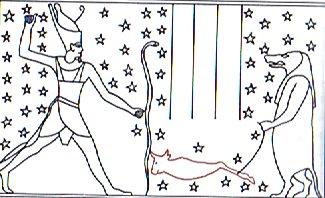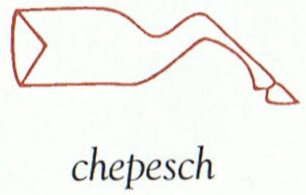There was a curious habit on Easter Island, where someone who had yet to take revenge of some past offense had a rat in his mouth - presumably with only its tail hanging outside visible to the world (in order to declare that the business was unfinished): "Rats were taboo as food for the island king and perhaps for the aristocratic Miru in general, probably because the rat was believed to be the incarnation of the spirit (kuhane) of the dead Hotu Matua. On the other hand, women were permitted to eat rats. One more reason why rats were valued was because the sinews of their tails were used by medicine men to sew up wounds. Finally, in the realm of beliefs, the rat figured in the heva cusom. If a kinsman had been murdered and the murderer was still at large, the avenger, in a state of rage, took a rat between his teeth and began to search for the murderer. Only when he had found out the name of the murderer did he let the rat, which by that time might be in a state of decomposition, fall to the ground and went and avenged the killing (HM:438-439)." (Barthel 2) The Rat = Kuhane of Hotu Matua (the Sun King) is apparently the Easter Island equivalent of The Heavenly Bull (Taurus) and during spring he will be responsible for the powerful growth:
65 is counted from Gb8-30. In Tahua the corresponding pair of glyphs could be Aa2-39--40:
Aa2-39 is a glyph which I once thought depicted one of the great stone statues (moai) and I classified it as a variant of the glyph type ure. ... carvers from Hotu Iti (eastern sector) journeyed to the western sector to seek the advice of a master carver. They were perplexed about how to resolve the difficult problem of carving the statue neck. He advised them to seek the answer by viewing their own bodies. They did so, and discovered that the model for the statue neck was the penis (ure) ... Ure Honu is the reincarnation of Hotu Matua and his Kuhane (the Rat) helped him to find the skull. The Thigh (Meschetiu) was in ancient Egypt the name for Ursa Major:
Though according to Wilkinson (who has furnished us with this picture) it was the front leg of a bull, not a hind leg (at least so at the time of the Middle Kingdom). With Ursa Major partaking in the process of generating a new year the head (skull) of the bull should be in the picture, I think. It is a time opposite to the 'tail'. Wilkinson explains that the constellation was the front leg of Seth, which Horus had torn loose and thrown up into the sky. The hieroglyph for the front leg of a bull (chepesch) was used to symbolize 'a strong arm':
Furthermore, chepesch was used in ceremonies when statues were raised up and also in front of a mummy when it was placed in the grave. This type of ceremony was called 'Opening of the Mouth'. The statues on Easter Island were 'sky-proppers', van Tilburg has suggested. And vaha mea apparently means the open mouth which symbolizes the red opening of a new year:
A moai is like a 'strong arm' (singular) capable of propping up the sky dome. Picture language is universal and the snake connecting thumb and bull's horn is like a kava sign, while the 3 vertical 'beams' look like those in Aa1-66:
The 'mouth' is still closed in Aa1-68 and maybe the haati in Aa1-77 (where 177 = 6 * 29.5) must first be broken off and flung up into the sky. At haati I have quoted from Fornander (regarding Hawaiian haki): ... Judge Andrews in his Hawaiian-English Dictionary observes the connection in Hawaiian ideas between 'speaking, declaring', and 'breaking'. The primary idea, which probably underlies both, is found in the Hawaiian 'to open, to separate, as the lips in speaking or about to speak'; and it will be observed that the same development in two directions shows itself in all the Polynesian dialects, as well as in several of the West Aryan dialects ... In Aa1-66 we should possibly count 16 * 6 = 96 in order to perceive the separation between the old year (9) and the new one (6). At left there are 2 + 2 (22) feathers and at right 3 + 2 (32). The fat season is at left and the hungry one at right. |
























